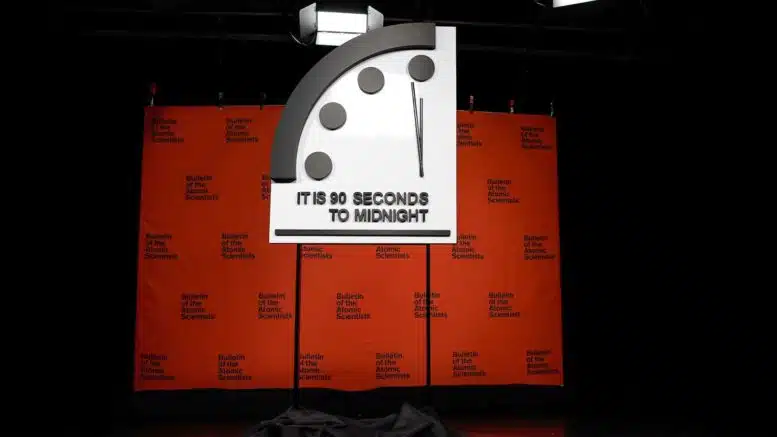The Doomsday Clock, a symbolic representation of humanity’s proximity to global catastrophe, has been a fixture for 77 years. This unconventional clock, established by the Bulletin of the Atomic Scientists in 1947, aims to convey the imminent danger of humanity destroying the world. Recently, the clock was set at 90 seconds to midnight, the closest it has ever been to the symbolic doomsday hour. Midnight signifies the point at which Earth becomes uninhabitable. The decision to maintain the same time on the clock this year is attributed to ongoing concerns such as the war in Ukraine, the Israel-Gaza conflict, the potential for a nuclear arms race, and the escalating climate crisis.
The Doomsday Clock is not a precise measurement of existential threats but rather a tool to initiate discussions on challenging scientific issues like climate change. The Bulletin of the Atomic Scientists, founded by scientists involved in the Manhattan Project, initially focused on nuclear threats but expanded its considerations to include climate change in 2007. The clock’s setting is determined annually by the Science and Security Board in collaboration with the Board of Sponsors, which includes Nobel laureates.
Rachel Bronson, the president and CEO of the Bulletin, highlighted concerns about the war in Ukraine, the Israel-Gaza conflict, the risk of a nuclear arms race, and the climate crisis as reasons for maintaining the clock at 90 seconds to midnight. She also expressed worries about advances in artificial intelligence, emphasizing the need to control a technology that could either enhance or threaten civilization in various ways.
While some critics question the Doomsday Clock’s efficacy, considering it an imperfect metaphor, others argue that it serves as a vital reminder of the fragility of our existence on Earth. The clock’s framing combines different types of risks, and its yearly adjustments aim to capture public attention regarding existential threats.
The Doomsday Clock has never reached midnight, and its custodians hope it never will. If midnight were to be reached, it would signify a nuclear exchange or catastrophic climate change leading to humanity’s demise. The clock’s accuracy is not intended to measure imminent threats but rather to stimulate conversation and public engagement in scientific topics like climate change and nuclear disarmament.
Bronson encourages individuals to engage in discussions about these critical issues and emphasizes the potential impact of public engagement on leaders. Taking inspiration from historical instances where the clock was moved away from midnight, she suggests that concrete actions, both individual and global, can positively influence the trajectory. Making small lifestyle changes, such as reducing reliance on vehicles and addressing home heating methods, is also promoted as a way for individuals to contribute to addressing climate change.

